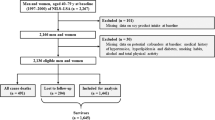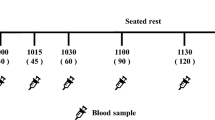Abstract
Objective:
To investigate the compliance of young girls with a soy intervention.
Design:
An 8-week dietary intervention and urine sample collection.
Setting:
Free-living girls.
Subjects:
A convenience sample of 8- to 14-y-old girls (20 started and 17 finished the study) recruited through flyers distributed to staff members and previous study participants.
Intervention:
The girls consumed one daily serving of soymilk, soy nuts, or tofu, completed 3-day food records, kept daily soy intake logs, and collected weekly urine samples.
Main outcome measures:
Compliance with the intervention was evaluated by daily soy intake logs, 3-day food records analyzed by the center's Food Composition and Food Groups Servings Databases, and weekly urinary isoflavone excretion using high-pressure liquid chromatography. The statistical analysis included paired t-tests, analysis of variance, and Spearman's rank-order correlation coefficients.
Results:
Daily soy intake logs indicated a mean intake of 6.28 servings out of a maximum of 7.0 servings per week. The food records revealed a six-fold increase in isoflavone intake during the study period (P<0.01) which was confirmed by an increase in urinary isoflavone excretion of similar magnitude (23.3–142.1 nmol/mg creatinine, P=0.02).
Conclusions:
This study demonstrated the ability of young girls to consume one daily soy serving and the usefulness of urinary isoflavones as a primary compliance measure. The high urinary isoflavone excretion levels detected in girls as compared to adult women suggest less intestinal degradation and/or greater absorption of isoflavones in nonadult populations. This finding requires further investigations into the pharmacokinetics of isoflavones.
This is a preview of subscription content, access via your institution
Access options
Subscribe to this journal
Receive 12 print issues and online access
$259.00 per year
only $21.58 per issue
Buy this article
- Purchase on Springer Link
- Instant access to full article PDF
Prices may be subject to local taxes which are calculated during checkout

Similar content being viewed by others
References
Adlercreutz H, Honjo H & Higashi A (1991): Urinary excretion of lignans and isoflavonoid phytoestrogens in Japanese men and women consuming a traditional Japanese diet. Am. J. Clin. Nutr. 54, 1093–1100.
Basiotis PP, Carlson A, Gerrior SA, Juan WY & Lino M (2002): The Healthy Eating Index: 1999–2000. US Department of Agriculture, Center for Nutrition Policy and Promotion. CNPP-12.
Beech BM, Klesges RC, Kumanyika SK, Murray DM, Klesges L, McClanahan B, Slawson D, Nunnally C, Rochon J, McLain-Allen B & Pree-Cary J (2003): Child- and parent-targeted interventions: the Memphis GEMS pilot study. Ethn. Dis. 13, S40–S53.
Center for Nutrition Policy and Promotion (1996): The Food Guide Pyramid. Washington, DC: United States Department of Agriculture.
Chen Z, Zheng W, Custer LJ, Dai Q, Shu XO, Jin F & Franke AA (1999): Usual dietary consumption of soy foods and its correlation with the excretion rate of isoflavonoids in overnight urine samples among Chinese women in Shanghai. Nutr. Cancer 33, 82–87.
Dai Q, Franke AA, Jin F, Shu XO, Hebert JR, Custer LJ, Cheng J, Gao YT & Zheng W (2002): Urinary excretion of phytoestrogens and risk of breast cancer among Chinese women in Shanghai. Cancer Epidemiol. Biomarkers Prev. 11, 815–821.
Franke AA & Custer LJ (1994): High-performance liquid chromatographic assay of isoflavonoids and coumestrol from human urine. J. Chromatogr. B 662, 47–60.
Franke AA, Custer LJ, Cerna CM & Narala K (1995): Rapid HPLC analysis of dietary phytoestrogens from legumes and from human urine. Proc. Soc. Exp. Biol. Med. 208, 18–26.
Franke AA, Custer LJ & Tanaka Y (1998a): Isoflavones in human breast milk and other biological fluids. Am. J. Clin. Nutr. 68, 1466S–1473S.
Franke AA, Custer LJ, Wang W & Shi SJ (1998b): HPLC analysis of isoflavonoids and other phenolic agents from foods and from human fluids. Proc. Soc. Exp. Biol. Med. 217, 263–273.
Hilakivi-Clarke L, Onojafe I, Raygada M, Cho E, Skaar T, Russo I & Clarke R (1999): Prepubertal exposure to zearalenone or genistein reduces mammary tumorigenesis. Br. J. Cancer 80, 1682–1688.
Irvine C (1995): The potential adverse effects of soybean phytoestrogens in infant feeding (Letter to the Editor). NZ. Med. J. 108, 208–209.
Karr SC, Lampe JW, Hutchins AM & Slavin JL (1997): Urinary isoflavonoid excretion in humans is dose dependent at low to moderate levels of soy-protein consumption. Am. J. Clin. Nutr. 66, 46–51.
Lamartiniere CA, Cotroneo MS, Fritz WA, Wang J, Mentor-Marcel R & Elgavish A (2002): Genistein chemoprevention: timing and mechanisms of action in murine mammary and prostate. J. Nutr. 132, 552S–558S.
Lamartiniere CA, Moore J, Holland M & Barnes S (1995): Neonatal genistein chemoprevents mammary cancer. Proc. Soc. Exp. Biol. Med. 208, 120–123.
Lampe JW, Gustafson DR, Hutchins AM, Martini MC, Li S, Wahala K, Grandits GA, Potter JD & Slavin JL (1999): Urinary isoflavonoid and lignan excretion on a Western diet: relation to soy, vegetable, and fruit intake. Cancer Epidemiol. Biomarkers Prev. 8, 699–707.
Lu LJW, Lin SN, Grady JJ, Nagamani M & Anderson KE (1996): Altered kinetics and extent of urinary daidzein and genistein excretion in women during chronic soy exposure. Nutr. Cancer 26, 289–302.
Maskarinec G, Robbins C, Riola B, Kane-Sample L, Franke A & Murphy S (2003): Three measures show high compliance in soy intervention among premenopausal women. J. Am. Diet. Assoc. 103, 861–866.
Maskarinec G, Singh S, Meng L & Franke AA (1998): Dietary soy intake and urinary isoflavone excretion among women from a multiethnic population. Cancer Epidemiol. Biomarkers Prev. 7, 613–619.
Murphy SP (2002): Unique nutrition support for research at the Cancer Research Center of Hawaii. Hawaii Med. J. 61, 15, 17.
Murrill WB, Brown NM, Zhang JX, Manzolillo PA, Barnes S & Lamartiniere CA (1996): Prepubertal genistein exposure suppresses mammary cancer and enhances gland differentiation in rats. Carcinogenesis 17, 1451–1457.
Neumark-Sztainer D, Story M, Perry C & Casey MA (1999): Factors influencing food choices of adolescents: findings from focus-group discussions with adolescents. J. Am. Diet. Assoc. 99, 929–937.
Ntambi JM, Choi Y, Park Y, Peters JM & Pariza MW (2002): Effects of conjugated linoleic acid (CLA) on immune responses, body composition and stearoyl-CoA desaturase. Can. J. Appl. Physiol. 27, 617–628.
Oshiro C, Maskarinec G, Petitpain D, Hebshi S & Novotny R (2004): A soy intervention in adolescent girls: design and implementation. J. Nutr. Educ. Behav. 36, 204–208.
Rochon J, Klesges RC, Story M, Robinson TN, Baranowski T, Obarzanek E & Mitchell M (2003): Common design elements of the Girls health Enrichment Multi-site Studies (GEMS). Ethn. Dis. 13, S6–S14.
Russo J & Russo IH (1995): Hormonally induced differentiation: a novel approach to breast cancer prevention. J. Cell. Biochem. Suppl. 22, 58–64.
Seow A, Shi CH, Franke AA, Hankin H, Lee HP & Yu MC (1998): Isoflavonoid levels in spot urine predict frequency of dietary soy intake in a population-based sample of middle-aged Chinese in Singapore. Cancer Epidemiol. Biomarkers Prev. 7, 135–140.
Setchell KD, Brown NM, Desai PB, Zimmer-Nechimias L, Wolfe B, Jakate AS, Creutzinger V & Heubi JE (2003): Bioavailability, disposition, and dose–response effects of soy isoflavones when consumed by healthy women at physiologically typical dietary intakes. J. Nutr. 133, 1027–1035.
Setchell KDR (1985): Naturally occurring non-steroidal estrogens of dietary origin. In: Estrogens in the environment, ed. JA McLachlan, pp 69–83. New York: Elsevier Science Publishing Co. Inc.
Sharma S, Murphy SP, Wilkens LR, Au D, Shen L & Kolonel LN (2003a): Extending a multiethnic food composition table to include standardized food group servings. J. Food Compos. Anal. 16, 485–495.
Sharma S, Murphy SP, Wilkens LR, Shen L, Hankin JH, Henderson B & Kolonel LN (2003b): Adherence to the Food Guide Pyramid recommendations among Japanese Americans, Native Hawaiians, and whites: results from the Multiethnic Cohort Study. J Am. Diet. Assoc. 103, 1195–1198.
Shu XO, Jin F, Dai Q, Wen W, Potter JD, Kushi LH, Ruan Z, Gao YT & Zheng W (2001): Soyfood intake during adolescence and subsequent risk of breast cancer among Chinese women. Cancer Epidemiol. Biomarkers Prev. 10, 483–488.
Soy Foods Association of North America. Soyfood Sales & Trends. http://www.soyfoods.org/press/FAQ_sales.htm. 2003 1-25-2003.
Soyatech Inc. US Retail Sales of Soy Foods (1992–2002). http://www.fda.gov/fdac/features/2000/soychart.html. 2003 Food and Drug Administration. 1-25-2003.
Strom BL, Schinnar R, Ziegler EE, Barnhart KT, Sammel MD, Macones GA, Stallings VA, Drulis JM, Nelson SE & Hanson SA (2001): Exposure to soy-based formula in infancy and endocrinological and reproductive outcomes in young adulthood. JAMA 286, 807–814.
US Department of Agriculture, Agricultural Research Service (2003): USDA National Nutrient Database for Standard Reference, Release 14. Nutrient Data Laboratory Home Page.Internet. 4-30-0003.
Van Horn LV, Stumbo P, Moag-Stahlberg A, Obarzanek E, Hartmuller VW, Farris RP, Kimm SY, Frederick M, Snetselaar L & Liu K (1993): The Dietary Intervention Study in Children (DISC): dietary assessment methods for 8- to 10-year-olds. J. Am. Diet. Assoc. 93, 1396–1403.
Wakai K, Egami I, Kato K, Kawamura T, Tamakoshi A, Lin Y, Nakayama T, Wada M & Ohno Y (1999): Dietary intake and sources of isoflavones among Japanese. Nutr. Cancer 33, 139–145.
Willett W (1998): Nutritional Epidemiology. New York: Oxford University Press.
Williams AE, Maskarinec G, Hebshi S, Oshiro C, Murphy S & Franke AA (2003): Validation of a soy questionnaire with repeated dietary recalls and urinary isoflavone assessments over one year. Nutr. Cancer 47, 118–125.
Wu AH, Wan P, Hankin J, Tseng CC, Yu MC & Pike MC (2002): Adolescent and adult soy intake and risk of breast cancer in Asian-Americans. Carcinogenesis 23, 1491–1496.
Zheng W, Dia Q, Custer LJ, Shu XO, Wen WQ, Jin F & Franke AA (1999): Urinary excretion of isoflavonoids and the risk of breast cancer. Cancer Epidemiol. Biomarkers Prev. 8, 35–40.
Zubik L & Meydani M (2003): Bioavailability of soybean isoflavones from aglycone and glucoside forms in American women. Am. J. Clin. Nutr. 77, 1459–1465.
Acknowledgements
We are grateful to the girls who participated in this study. This investigation was supported by a Research Centers in Minority Institutions Award, P20 RR11091, from the National Center for Research Resources, National Institutes of Health. Thank you to DrSoy Nutrition, Aloha Tofu Factory and Foodland Supermarkets for supplying us with soy foods. We would also like to acknowledge our dedicated staff members for their efforts, including Andrew Williams, MA, Debra Petitpain, MS, RD, and Laurie Custer, BS.
Author information
Authors and Affiliations
Corresponding author
Additional information
Guarantor: G Maskarinec.
Contributors: GM conceived the idea for the study and directed the project, the analysis, and the manuscript preparation; CO developed the nutritional education strategy; CO and YM prepared the first draft; YM performed the statistical analysis; SH coordinated the project and wrote part of the methods; RN provided nutritional consultation; AAF participated in the planning and was responsible for the analytical work; all authors reviewed the final manuscript.
Rights and permissions
About this article
Cite this article
Maskarinec, G., Oshiro, C., Morimoto, Y. et al. Urinary isoflavone excretion as a compliance measure in a soy intervention among young girls: a pilot study. Eur J Clin Nutr 59, 369–375 (2005). https://doi.org/10.1038/sj.ejcn.1602083
Received:
Revised:
Accepted:
Published:
Issue Date:
DOI: https://doi.org/10.1038/sj.ejcn.1602083



